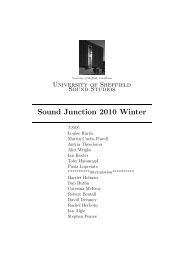Compositional Methods in Electroacoustic Music - Adrian Moore ...
Compositional Methods in Electroacoustic Music - Adrian Moore ...
Compositional Methods in Electroacoustic Music - Adrian Moore ...
Create successful ePaper yourself
Turn your PDF publications into a flip-book with our unique Google optimized e-Paper software.
Scott, Richard<br />
STEIM, Lancaster University<br />
A discussion of the very different senses of time experienced by the electroacoustic composer and programmer/<strong>in</strong>strument<br />
designer and that of the improviser <strong>in</strong> performance and of the questions these create for those<br />
design<strong>in</strong>g <strong>in</strong>struments and <strong>in</strong>terfaces for electroacoustic composition, improvisation and performance.<br />
A digital system, whether computer, sampler, sequencer or synthesizer, is above all a way of translat<strong>in</strong>g, preserv<strong>in</strong>g<br />
and address<strong>in</strong>g time and memory. Digital technology functions by separation and division and by predeterm<strong>in</strong>ation.<br />
It separates the processes of programm<strong>in</strong>g and perform<strong>in</strong>g and divides them <strong>in</strong>to two quite<br />
different concepts of time. Programm<strong>in</strong>g time is compared to the productive conditions of conventional (paper<br />
or electroacoustic) fixed media composition; <strong>in</strong> both there is no organic relationship between the time of<br />
the music’s composition and the moment of the music’s performance. The fixed composition is a ‘piece’ because<br />
it is abstracted from the time of its creation and has become fixed: it’s is a pre-determ<strong>in</strong>ed ‘piece’ of<br />
time that has become abstract from time.<br />
Contrast this with the irreversible and <strong>in</strong>divisible moment of improvisation: an immediate social and somatic<br />
encounter located <strong>in</strong> the present, between actors and witnesses, between performers and audience. Quot<strong>in</strong>g<br />
Nietzsche, Kent De Spa<strong>in</strong>, Derek Bailey and John Stevens, these encounters are perceived as k<strong>in</strong>ds of immediate<br />
acts and as <strong>in</strong>timate personal sonic and temporal relationships.<br />
But temporal and somatic <strong>in</strong>timacy is challenged by technology. Exist<strong>in</strong>g and emerg<strong>in</strong>g technologies offer the<br />
electroacoustic improviser access to what represents an almost <strong>in</strong>f<strong>in</strong>ite virtual digital memory. <strong>Electroacoustic</strong><br />
improvisers are no longer limited by immediate time or by their own bodies. The time and memory that<br />
was once subjectively encapsulated with<strong>in</strong> the body of the performer is now held <strong>in</strong> the mach<strong>in</strong>e. The mach<strong>in</strong>e<br />
is <strong>in</strong>creas<strong>in</strong>gly do<strong>in</strong>g our remember<strong>in</strong>g for us. Does that liberate us from the task? Or does it make us<br />
mach<strong>in</strong>e-dependent? The <strong>in</strong>adequacy and failure of human memory might itself also be an importance source<br />
of creativity and new ideas. The idea that improvisation conta<strong>in</strong>s the necessity not just for remember<strong>in</strong>g, but<br />
also for forgett<strong>in</strong>g, is considered: because we forget, we must <strong>in</strong>vent.<br />
If qualities of <strong>in</strong>timacy and timel<strong>in</strong>ess are to be ma<strong>in</strong>ta<strong>in</strong>ed time must be kept permeable by unpredictable<br />
events, not closed to them. Mach<strong>in</strong>e memory should not be allowed determ<strong>in</strong>e either the detail or boundaries<br />
of what occurs <strong>in</strong> improvised electroacoustic performance. How can we design <strong>in</strong>struments, which go beyond<br />
what we can predict and what we already know? How can we make a truly <strong>in</strong>teractive electroacoustic music<br />
that ma<strong>in</strong>ta<strong>in</strong>s a real contact with time as it unfolds, and share this immediate experience with others?<br />
Paper 25 - M<strong>in</strong>ature form <strong>in</strong> electroacoustic and <strong>in</strong>strumental new music.<br />
11:00<br />
Chippewa, Jef<br />
In recent years, <strong>in</strong> both the <strong>in</strong>strumental New <strong>Music</strong> and electroacoustic milieux, there seems to have been<br />
an <strong>in</strong>creas<strong>in</strong>g <strong>in</strong>terest <strong>in</strong> m<strong>in</strong>iatures, works hav<strong>in</strong>g a duration of less than a specific threshold. There is, however,<br />
a surpris<strong>in</strong>g shortfall of reflection and discussion on the nature of the m<strong>in</strong>iature or the ‘work of limited<br />
duration’. With a certa<strong>in</strong> number of projects promot<strong>in</strong>g the form now hav<strong>in</strong>g been realized and a large number<br />
of works available which purport to be <strong>in</strong> m<strong>in</strong>iature form, we are now able to make an assessment of the<br />
nature of this particular musical form by ask<strong>in</strong>g such questions as: Why it is relevant or <strong>in</strong>terest<strong>in</strong>g to compose<br />
<strong>in</strong> this form(at)? More fundamentally, what <strong>in</strong> fact constitutes a ‘m<strong>in</strong>iature’? The few discussions that<br />
do address the differences between m<strong>in</strong>iature and non-m<strong>in</strong>iature form typically concern duration, with no conclusive<br />
explanation of why the particular duration (vary<strong>in</strong>gly 60 or 90 seconds, 3 or 5 m<strong>in</strong>utes) was found to<br />
be an appropriate threshold to establish a piece as a m<strong>in</strong>iature (and therefore make it eligible for a particular<br />
project).<br />
Many works of limited duration might more aptly be deemed short works rather than m<strong>in</strong>iatures, as they<br />
display <strong>in</strong>disputable correspondences to one or another form type already established by larger scale compositions.<br />
Us<strong>in</strong>g the term ‘m<strong>in</strong>iature’ to refer to a specific piece is a qualitatively different declaration than<br />
referr<strong>in</strong>g to it as ‘a short work’, or even ‘work of limited duration’. Accord<strong>in</strong>gly, for a musical work to be considered<br />
a ‘m<strong>in</strong>iature’ as opposed to ‘a short composition‘, a ‘pop format’ or ‘radio format’ work, for example ,<br />
it will need to conform to certa<strong>in</strong> basic criteria, <strong>in</strong>dependent of the work’s duration. Here, it is proposed that<br />
27



